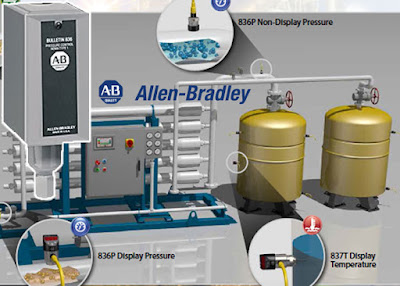Rockwell offers automation of a unique lineup of Alan Bradley® sensor products to meet the requirements of your Pressure Sensors application needs. The products come with capable models of detecting temperature, pressure, flow and level. The Allen Bradley solid-state remote sensing case and electric switches provide exceptional control for the automatic operation of machines and processes.
A pressure sensor is a device that senses the pressure and converts it into an analog electric signal that depends on the pressure exerted on the volume. They are also referred to as a pressure transducer because they convert pressure to electrical signals. Pressure sensor has been widely used in fields for a long time, such as aerospace, auto manufacturing, air conditioning, biomedical measurement, water measurements etc.
Image by http://ab.rockwellautomation.com
Pressure sensor is an important part of the ABS in security purposes. This system adjusts the nature of the earth and makes sure that in case of braking at high speed. The tires do not lock and the car does not slip. Pressure sensor is in the details of the ABS processor for road conditions and vehicle transfer speed. The airbag system also uses a pressure sensor. So the bag can be activated to ensure the safety of passengers every time a high amount of pressure is experienced by the vehicle.
Allen Bradley 836 Electromechanical Pressure Controls design is made to control or operating conditions for different types of aerobic or hydraulics applications. These controls can improve processes and systems and help maintain the operator and protect expensive equipment.
The features of this Electromechanical Pressure Control product are stated bellow:
a. It includes an adjustable range of 30 in Mercury unemployment ... 900 lbs
b. Offers rugged, compact design
c. Provide copper alloy or stainless steel cone
d. Including an adjustable differential range of 0.2 ... 125 lbs
e. Available in open type or type 1, 13/04, 4X, 09/07 and 13/04 Joint enclosure
f. Including a wide range of communication arrangements
g. Provide standard and custom cooling controls
This Bulletin 836 Electromechanical Pressure Controls is designed to control or monitor operating conditions for different types of aerobic or hydraulics applications including: air compressor, low monitors and high pressure and vacuum conveyor machine.
A pressure sensor is a device that senses the pressure and converts it into an analog electric signal that depends on the pressure exerted on the volume. They are also referred to as a pressure transducer because they convert pressure to electrical signals. Pressure sensor has been widely used in fields for a long time, such as aerospace, auto manufacturing, air conditioning, biomedical measurement, water measurements etc.
Electromechanical Pressure Control In the automotive industry
In the automotive industry, pressure sensors are an integral part of the device and its safety. In the engine, this sensor monitors the oil pressure and the coolant and adjusts the power of the engine. That must provide to achieve a speed that corresponds to each time the pedal is pressed or applied to the brakes of the vehicle.Pressure sensor is an important part of the ABS in security purposes. This system adjusts the nature of the earth and makes sure that in case of braking at high speed. The tires do not lock and the car does not slip. Pressure sensor is in the details of the ABS processor for road conditions and vehicle transfer speed. The airbag system also uses a pressure sensor. So the bag can be activated to ensure the safety of passengers every time a high amount of pressure is experienced by the vehicle.
Electromechanical Pressure Control made to control or operating conditions for different types of aerobic or hydraulics applications
Today the technology industry is a priority function. The use of electromechanical automation to control the manufacturing process can increase competitiveness and productivity in the global economy. It also requires trained technicians who can service, maintain, install and retrofit this sophisticated equipment.Allen Bradley 836 Electromechanical Pressure Controls design is made to control or operating conditions for different types of aerobic or hydraulics applications. These controls can improve processes and systems and help maintain the operator and protect expensive equipment.
The features of this Electromechanical Pressure Control product are stated bellow:
a. It includes an adjustable range of 30 in Mercury unemployment ... 900 lbs
b. Offers rugged, compact design
c. Provide copper alloy or stainless steel cone
d. Including an adjustable differential range of 0.2 ... 125 lbs
e. Available in open type or type 1, 13/04, 4X, 09/07 and 13/04 Joint enclosure
f. Including a wide range of communication arrangements
g. Provide standard and custom cooling controls
This Bulletin 836 Electromechanical Pressure Controls is designed to control or monitor operating conditions for different types of aerobic or hydraulics applications including: air compressor, low monitors and high pressure and vacuum conveyor machine.
